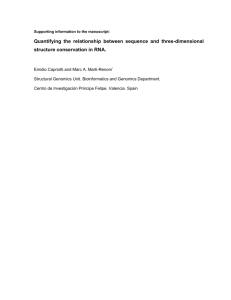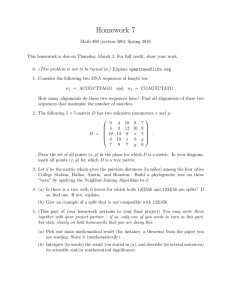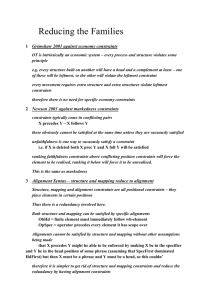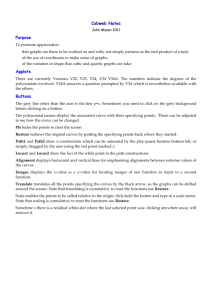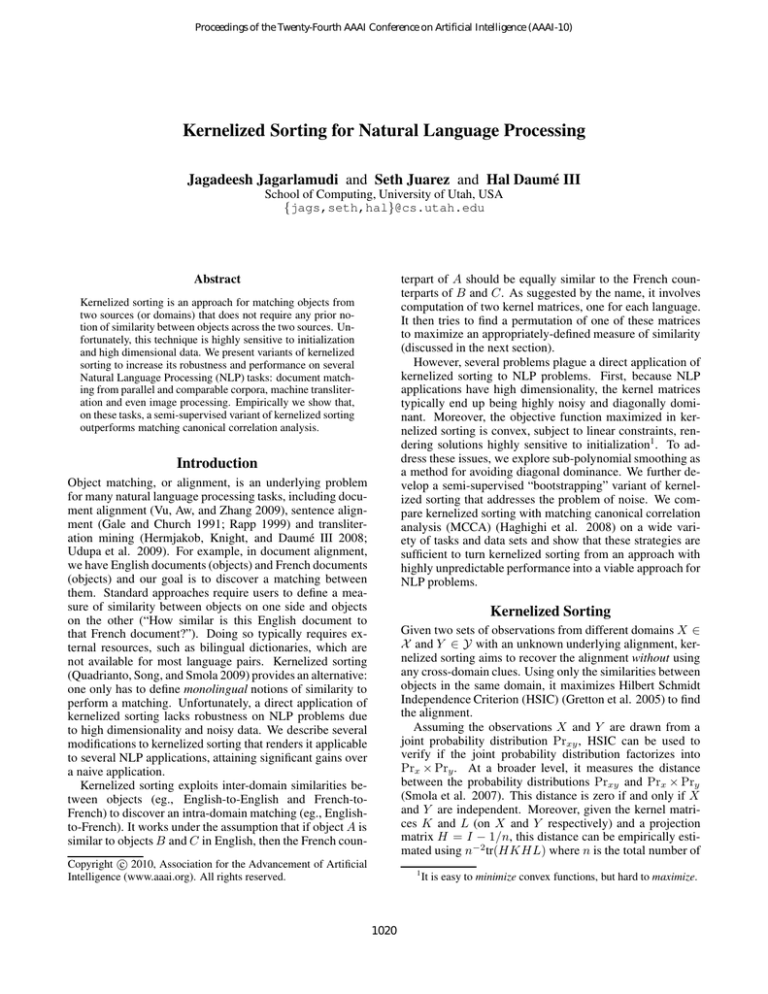
Proceedings of the Twenty-Fourth AAAI Conference on Artificial Intelligence (AAAI-10)
Kernelized Sorting for Natural Language Processing
Jagadeesh Jagarlamudi and Seth Juarez and Hal Daumé III
School of Computing, University of Utah, USA
{jags,seth,hal}@cs.utah.edu
terpart of A should be equally similar to the French counterparts of B and C. As suggested by the name, it involves
computation of two kernel matrices, one for each language.
It then tries to find a permutation of one of these matrices
to maximize an appropriately-defined measure of similarity
(discussed in the next section).
However, several problems plague a direct application of
kernelized sorting to NLP problems. First, because NLP
applications have high dimensionality, the kernel matrices
typically end up being highly noisy and diagonally dominant. Moreover, the objective function maximized in kernelized sorting is convex, subject to linear constraints, rendering solutions highly sensitive to initialization1 . To address these issues, we explore sub-polynomial smoothing as
a method for avoiding diagonal dominance. We further develop a semi-supervised “bootstrapping” variant of kernelized sorting that addresses the problem of noise. We compare kernelized sorting with matching canonical correlation
analysis (MCCA) (Haghighi et al. 2008) on a wide variety of tasks and data sets and show that these strategies are
sufficient to turn kernelized sorting from an approach with
highly unpredictable performance into a viable approach for
NLP problems.
Abstract
Kernelized sorting is an approach for matching objects from
two sources (or domains) that does not require any prior notion of similarity between objects across the two sources. Unfortunately, this technique is highly sensitive to initialization
and high dimensional data. We present variants of kernelized
sorting to increase its robustness and performance on several
Natural Language Processing (NLP) tasks: document matching from parallel and comparable corpora, machine transliteration and even image processing. Empirically we show that,
on these tasks, a semi-supervised variant of kernelized sorting
outperforms matching canonical correlation analysis.
Introduction
Object matching, or alignment, is an underlying problem
for many natural language processing tasks, including document alignment (Vu, Aw, and Zhang 2009), sentence alignment (Gale and Church 1991; Rapp 1999) and transliteration mining (Hermjakob, Knight, and Daumé III 2008;
Udupa et al. 2009). For example, in document alignment,
we have English documents (objects) and French documents
(objects) and our goal is to discover a matching between
them. Standard approaches require users to define a measure of similarity between objects on one side and objects
on the other (“How similar is this English document to
that French document?”). Doing so typically requires external resources, such as bilingual dictionaries, which are
not available for most language pairs. Kernelized sorting
(Quadrianto, Song, and Smola 2009) provides an alternative:
one only has to define monolingual notions of similarity to
perform a matching. Unfortunately, a direct application of
kernelized sorting lacks robustness on NLP problems due
to high dimensionality and noisy data. We describe several
modifications to kernelized sorting that renders it applicable
to several NLP applications, attaining significant gains over
a naive application.
Kernelized sorting exploits inter-domain similarities between objects (eg., English-to-English and French-toFrench) to discover an intra-domain matching (eg., Englishto-French). It works under the assumption that if object A is
similar to objects B and C in English, then the French coun-
Kernelized Sorting
Given two sets of observations from different domains X ∈
X and Y ∈ Y with an unknown underlying alignment, kernelized sorting aims to recover the alignment without using
any cross-domain clues. Using only the similarities between
objects in the same domain, it maximizes Hilbert Schmidt
Independence Criterion (HSIC) (Gretton et al. 2005) to find
the alignment.
Assuming the observations X and Y are drawn from a
joint probability distribution Prxy , HSIC can be used to
verify if the joint probability distribution factorizes into
Prx × Pry . At a broader level, it measures the distance
between the probability distributions Prxy and Prx × Pry
(Smola et al. 2007). This distance is zero if and only if X
and Y are independent. Moreover, given the kernel matrices K and L (on X and Y respectively) and a projection
matrix H = I − 1/n, this distance can be empirically estimated using n−2 tr(HKHL) where n is the total number of
c 2010, Association for the Advancement of Artificial
Copyright Intelligence (www.aaai.org). All rights reserved.
1
1020
It is easy to minimize convex functions, but hard to maximize.
vectors, i.e. we have aligned the relationships with other
objects, and now we will try to find a best match between
observations according to current πi . This is done by first
building a weighted bipartite graph between X and Y , with
weights equal to hXi , Yj i (step 2)3 . And then (step 3), a LAP
solver finds an optimal assignment of observations in set Y
to observations in set X which becomes our new permutation matrix πi+1 for step 4. This process continues until the
convergence in the objective function value.
Problems in Adapting to NLP
Since kernelized sorting involves a maximization of a convex function, tr(K̄π T L̄π), it is sensitive to the initialization
of π. Quadrianto, Song and Smola (2009) suggest using the
projection on first principal components (referred as principal component based initialization) as the initial permutation
matrix. This initialization increases data dependency. They
report that kernelized sorting is able to recover 140 pairs
of images out of 320 (data set is described in “Experimental
Setup” Section). In our preliminary experiments (using their
code), we varied the number of image pairs and plotted the
number of recovered alignments (Fig. 2). It can be clearly
seen that its performance is very sensitive to the data and is
unpredictable. Adding an additional 10 pairs of images to
a data set with 190 pairs decreases the number of recovered
alignments from 78 to zero. Kernel matrices computed over
textual data tend to be very noisy and thus pose a further
threat to the robustness of its direct application.
Apart from the issue of robustness, the diagonal dominance of kernel matrices used in NLP applications also
creates a major problem. Since kernelized sorting relies
on maximizing an empirical estimate of HSIC, the bias involved in this estimate becomes important when kernel matrices are diagonally dominant. To understand this, consider
the objective function being maximized in the iterative step
tr(K̄ L̂), where L̂ = L̄πi . This objective function can be
rewritten as:
X
X
X
K̄ij L̂ij =
K̄ij L̂ij +
K̄ii L̂ii
Figure 1: The process of kernelized sorting to match observations in Y & X
observations in each domain.
Since kernelized sorting aims to find a best correspondence between the observations, it maximizes the dependency (as measured by HSIC) of the kernel matrices. By
representing an alignment in terms of a permutation matrix
π ∈ {0, 1}n×n, where πij = 1 indicates the alignment between observations Xj and Yi , finding the best alignment is
formulated as an optimization problem:
π∗
= arg max tr(K̄π T L̄π)
π∈Πn
s.t. π1n = 1n & π T 1n = 1n
(1)
(2)
where K̄ := HKH and L̄ := HLH are data centered
versions of K and L respectively, Πn is the set of all permutation matrices of size n × n and 1n is a column vector
of ones of size n. The constraints (Eqn. 2) together with
πij ∈ {0, 1} indicate that an observation in one domain is
allowed to be aligned to only one observation in another domain2 . Intuitively, in the operation π T L̄π, applying π from
the right interchanges the columns of matrix L̄ so that the
ith dimension of resulting Y vectors is aligned to the ith dimension
ofX vectors. For example, the effect of applying
0 1
π=
on L̄ interchanges the first and second column
1 0
(shown in the step 1 of Fig. 1). Similarly applying from
the left interchanges the rows so that the new ith observation corresponds to observation Xi . The optimization problem (Eqn. 1) is solved iteratively, i.e. given a permutation
matrix πi at ith iteration, we fix πi and solve for the permutation matrix πi+1 given by arg maxπ tr(K̄π T L̄πi ). This
optimization problem is converted into a Linear Assignment
Problem (LAP) (Jonker and Volgenant 1987) and solved for
optimal πi+1 .
The entire process is depicted in Figure 1. In the beginning there are no alignments between the sets of observations and hence the algorithm picks some initial permutation π0 . At any iteration, the columns of L̄ are permuted
according to the current permutation πi so that the dimensions of both the sets of observations match (step 1). As discussed previously this aligns the dimensions of observation
2
ij
i,j s.t.i6=j
i
If the kernel matrices are diagonal dominant, then the similarity of an object with itself dominates the similarity with
the rest of the objects in the same domain. Thus while finding an optimal πi+1 , we end up aligning this object to an
equally self-similar object in the other domain. As a result
the similarity of an observation with the rest of the observations from the same domain becomes moot. NLP applications are known for their huge dimensionality and nearorthogonal feature vectors and hence this issue becomes crucial.
In the next couple of sections we suggest two simple and
practical improvements to kernelized sorting to handle both
diagonal dominance and noisy kernels.
Sub-polynomial Kernel
Diagonal dominance also creates problem in other scenarios
like Support Vector Machine learning and document Clus3
We will relax this constraint in the following sections.
1021
In this particular case Yj is the permuted vector in step 1.
0
1
0
0
1
0
0
0
0
0
0
0
0.5 0.5
0.5 0.5
0
1
0
0
1
0
0
0
0
0
0
0
0
0
0
0
Uniform wts.
Zero wts.
Table 1: Permutation matrices corresponding to the relaxed
strategies in the presence of seed alignments.
Seed Alignments
As discussed in earlier sections, the performance of kernelized sorting significantly drops when the kernel matrices are
noisy. In this section we propose another improvement to
kernelized sorting which helps in recovering alignment in
such situations.
Since kernelized sorting tries to find a globally consistent alignments, even low confidence, and quite possibly incorrect alignments, will have equal effect as any confident
(probably correct) alignments in determining the next permutation matrix. The key idea is to first rank the alignments
at any iteration and give preference to top ranked alignments
than the low confident ones. As a result, the incorrect alignments will have minimal effect in determining the future permutation matrix and hopefully the alignments become better
and better with each iteration. In step 3 of the algorithm (Fig.
1), the new permutation matrix is determined by solving a
linear assignment problem. The output of this stage is a set
of weighted correspondences between observations in different domains. We can use this weight to identify the (probably) correct alignments from incorrect ones. But, since the
algorithm runs in an unsupervised setting an incorrect permutation matrix at initial iterations can cause bad correspondences to receive high weight. Hence this weight may not be
a good indicator of accuracy of an alignment. To overcome
this, we provide an initial set of seed alignments to the algorithm and force the algorithm to respect these alignments in
every iteration.
Given an initial set of seed alignments4 , the algorithm
starts with a permutation matrix π0 s.t. π0ij = 1 if observation Yi is aligned to Xj in the initial seed. We relaxed
the constraints on the permutation matrix (Eqn. 2) and explored two strategies for the remaining observations: uniform weights (wu ) and zero weights (wz ). Table 1 shows
an example seed alignments and the corresponding permutation matrix for both the strategies5 . After the columns of
L̄ are permuted (step 1 of Fig 1), a weighted bipartite graph
is constructed. In this particular example, the edge weights
are computed as hXj , (YiT π)T i:
Figure 2: Number of recovered alignments on image data
set using naive KS technique.
tering (Greene and Cunningham 2006). Sub-polynomial
kernels (Schölkopf et al. 2002) have been proposed to address the issue of large diagonal elements in the SVM literature. Given a kernel function corresponding to a feature map
φ and a scalar p s.t. 0 < p < 1, the sub-polynomial kernel
function is defined as:
kSP (xi , xj ) = hφ(xi ), φ(xj )ip
Let K be the kernel matrix corresponding to the unmodified kernel function, then the sub-polynomial kernel matrix
KSP can be easily computed by raising each element to the
power p. Since p < 1, elements that are less than one will increase while elements that are greater than one will decrease.
This operation decreases the range in which the modified elements lie and as a result the ratio of diagonal elements to
the off-diagonal elements decrease.
Unfortunately KSP may no longer be a positive definite
matrix. To convert into a valid kernel matrix, first the rows
are normalized to unit length and then a gram matrix is comT
puted as KSP ← KSP × KSP
. If we consider the observations in set X, this transformation has the effect of first
representing each observation in terms of its similarity with
all observations and then a new similarity is defined between
two objects based on the closeness of their similarity vectors.
In general, the problem with using sub-polynomial kernel
is the need to choose the value of the parameter p. This however turns out to be an advantage of using sub-polynomial
kernels for the problem at hand. Recall that kernelized sorting is sensitive to initialization, each value of p give us two
new kernel matrices and each such pair will result in a new
initialization matrix (the projection onto first principal components). Since each of these principal component based
initializations is likely to find a better solution than a random initialization, the process of searching for the value of
p gives us a systematic way to explore different possible candidate initializations. From the resulting solutions we take
the permutation matrix that achieves highest objective function value.
wu (Yi , Xj )
wz (Yi , Xj )
= Yi2 Xi1 + Yi1 Xi2
+ 0.5 ∗ (Yi3 + Yi4 ) ∗ (Xi3 + Xi4 )
= Yi2 Xi1 + Yi1 Xi2
Notice that in both these cases the alignments of Y3 and Y4
do not have any effect on the edge weights and hence the
assignments of the LAP solver will not be effected by the
4
5
1022
used only 10 seed alignments in our experiments.
Recall that πij = 1 if observations Yi and Xj are aligned.
The image data set is same as the one used in (Quadrianto,
Song, and Smola 2009) and is preprocessed in the same
manner. For the transliteration data set, the Arabic names are
romanized first and then each name in both the languages is
converted into a vector by considering all possible unigram,
bigram and trigram character sequences. Again a simple linear dot product kernel is used to build the kernel matrices in
both English and Arabic.
We compare our system with a direct application of kernelized sorting (KS) technique and MCCA (Haghighi et al.
2008). For KS, we use the same experimental setup used
by Quadrianto, Song, and Smola (2009): zero out the diagonal elements, use principal component based initialization
and a convex combination of previous permutation matrix
and the current solution of LAP solver. MCCA is a semisupervised technique that uses a set of seed alignments. In
each iteration it uses Canonical Correlation Analysis (CCA)
(Hotelling 1936) to compute the directions along which already aligned observations are maximally correlated. Then
it finds the alignment between new observations by mapping
them into the sub-space found by CCA and then selectively
updates the seed list. We use same set of seed alignments
for both MCCA and our approach.
alignments of these observations. However with uniform
weighting, even though the alignments of Y3 and Y4 do not
matter, the similarities of Y3 and Y4 with other objects from
the same domain (captured in terms of Yi3 and Yi4 respectively) will still effect the edge weights. Where as they won’t
have any effect on edge weights in zero weighting case.
Since applying LAP solver on this weighted graph may
produce an inconsistent assignment for observations Y1 and
Y2 , with respect to seed alignments, we perturb the edge
weights by assigning high weight to an edge in the seed
alignments and thus the LAP solver is forced to respect seed
alignments. The new permutation matrix is formed by considering the most highly weighted ki + δ assignments of the
LAP solver, where ki is the number of confident alignments
at current iteration and δ (set to 2 in our experiments) is the
number of new alignments added at each iteration. Thus
at any iteration, we can reduce the effect of low confidence
alignments in future permutation matrix while being consistent with the initial seed alignments. This process is repeated
until the desired criterion is met.
Experimental setup
Since our main suggestions are ways to deal with diagonal
dominance and noisy kernels, we focus mostly on evaluating on NLP tasks which are known for both these problems
due to high dimensionality. We compare our system with
MCCA (Haghighi et al. 2008) on the task of aligning documents written in multiple languages and the task of finding
transliteration equivalents between names in different languages. To evaluate the robustness of our suggestions we
also evaluate on the image alignment task as introduced by
(Quadrianto, Song, and Smola 2009).
We use the following three data sets for the task of aligning documents:
Results
We evaluate our suggestions incrementally:
• p -smooth: only sub-polynomial kernels with the principal component based initialization.
• S-U: p-smooth and ten random seed alignments with uniform weights for low confident alignments.
• S-Z: p-smooth and ten random seed alignments with zero
weights for low confident alignments.
When using sub-polynomial kernel, we try all values of p
from 0.01 to 1 with an increment of 0.01. At each value of p,
we consider both the principal component based initialization and the solution corresponding to the previous value of
p and keep the permutation that gives the maximum objective function value. In general we found that the best value
of p lies in the range of 0.05 and 0.6. Table 2 reports the
number of recovered alignments on all the tasks.
• EP-P: 250 pairs of parallel documents extracted from EuroParl English and Spanish corpus (Koehn 2005).
• EP-C: 226 pairs of comparable documents artificially
constructed out of EuroParl corpus by considering only
the first half of English document and second half of the
aligned Spanish document.
Aligning Images
• WP: 115 pairs of aligned comparable articles from
Wikipedia.
First we report the results on the task of aligning images.
The baseline system (KS) recovered 137 pairs of alignments
while p-smooth also retrieved 136 pairs (fourth column of
table 2). Though there is not much of difference between
the number of recovered alignments with all the 320 pairs
of images, p-smooth is more robust to changes in the data
set as shown in Fig. 3. We start with five pairs of images
and add five pairs in each step and let the systems determine
the alignment. From the figure it is clear that, the performance of the baseline system crucially depends on the data
set, while the dependence is not vital when the kernels are
smoothed using sub-polynomial kernels.
For all the above data sets, documents are first preprocessed
to remove stop words and words are stemmed using snowball stemmer http://snowball.tartarus.org/.
The preprocessed documents are converted into TFIDF vectors and then a linear dot product kernel is used to build the
required kernel matrices.
We use the following data sets for the remaining two
tasks:
• TL: 300 pairs of multi-word name transliterations between English and Arabic for the task of finding transliteration equivalents, derived from (Hermjakob, Knight, and
Daumé III 2008).
Aligning Documents and Transliterations
The results on both document alignment task and the task
of matching transliterations are also reported in Table 2.
• IMG: 320 pairs of images of size 20 × 40 pixels.
1023
Figure 4: Number of recovered alignments (y-axis) is plotted against the value of p (x-axis) on TL data set.
Figure 3: Number of recovered alignments on image data
set. Both the naive KS and p-smooth are shown.
IMG (320)
EP-P (250)
EP-C (226)
WP (115)
TL (300)
KS
MCCA
p-smooth
S-U
S-Z
137
6
2
5
7
35
250
34
48
209
136
250
41
11
30
144
250
88
76
250
144
250
88
81
262
values of p we perturb the data slightly and subsequently the
objective function being maximized helps us in identifying
the correct perturbation and hence a better alignment.
We also study the effect of the parameter p which controls the smoothing of kernel matrices. In Fig. 4 we plot
the number of recovered alignments on the task of finding
named entity transliterations (TL dataset) with the value of
p. For both S-U and S-Z runs, the seed alignments constitute
the initial permutation matrix. In these runs, accuracies increase till certain value of p and then start decreasing. This is
very intuitive because, for very small values of p the ratio of
highest element to the lowest element in the matrix becomes
almost one and hence it doesn’t distinguish the vectors. As
the value of p becomes high, close to one, the performance
again decreases because of the diagonal dominance. The
curves for other data sets are similar and in general, for the
datasets we experimented, the best value of p was found in
the range from 0.05 to 0.6.
Table 2: Number of Aligned pairs on all data sets. p-smooth
and KS do not require seed alignments
Though KS performed competitively in aligning images, it
recovers almost none of the alignments in case documents
and transliterations6.
On the task of aligning parallel documents (EP-P), though
both MCCA and our runs are able to recover all the alignments, our approach didn’t require any seed alignments (psmooth). This is because when the data is parallel, both
source and target kernel matrices look almost identical. That
is, the similarity vector of an observation Yi (with other observations from Y) is nearly the same as the similarity vector
of its aligned observation Xai (with observations from X ).
In this case, removing the diagonal dominance is enough to
recover all alignments.
As the data becomes less parallel, the kernel matrices start
becoming noisy and hence p-smooth by itself is not able
to retrieve many document pairs. In this case, providing a
small set of ten random seed alignments turned out to be
very helpful in improving the accuracies, especially for WP
and TL datasets. Though both the weighting strategies performed competitively, assigning zero weights, thus ignoring
the low confident alignments completely, is marginally better in TL and WP data sets. Both our runs (S-U and S-Z)
outperformed MCCA especially when the kernels are noisy,
and we believe it is because while searching for different
Discussion and Future Work
At first glance, it may appear that the assumptions of kernelized sorting: requirement of equal number of observations
from both domains and the one-to-one alignment for every
observation are too restrictive for its application to NLP. For,
these assumptions are often not true in the case of NLP applications due to the inherent ambiguity of natural language.
In this section, we argue that the technique can be modified
to handle these cases. First, we empirically show that having
noisy observations, i.e. observations without an aligned object in other domain, doesn’t severely effect the performance
of the technique. And then we suggest modifications to handle situations where the other assumptions could potentially
break.
To study the effect of noise, we have added some random examples (with out any aligned object in other domain)
in each domain to EP-C and TL data sets. Table 3 shows
the number of alignments recovered by both MCCA and SZ strategies. The presence of noisy examples equally ef-
6
For baseline system, we use the same code available from the
http://users.rsise.anu.edu.au/ nquadrianto/kernelized sorting.html
1024
EP-C
TL
#Aligned
#Noisy
MCCA
S-Z
200
300
26
50
31 (34)
185 (209)
69 (88)
236 (262)
tasks. Empirical results on various tasks and data sets show
not only the improved robustness but also better accuracies
compared to MCCA (a semi-supervised technique based on
CCA).
Acknowledgements
Table 3: Second column indicates the number of aligned
pairs and the third column indicates the number of noisy examples added. New noisy pairs were added for TL data set
while existing pairs were made noisy in EP-C data set.
We thank the anonymous reviewers for their helpful comments. This work was partially supported by NSF grant IIS0916372.
References
fected both the algorithms (compared to the number of recovered alignments with out noisy pairs, shown in parenthesis). Though we didn’t experiment this, another possible
technique to handle the noisy examples could be to stop the
algorithm at intermediate iterations instead running it until
it finds an alignment for every observation. The extension
of this algorithm to situation with different number of observations on each side is also straight forward. Instead of π
being a square matrix of size n, it will now become a rectangular matrix of appropriate size and the input to the LAP
solver (step 3 of Fig. 1) is modified by adding dummy nodes
on the side with fewer observations and assigning a very low
weight to edges connecting these nodes so as to discourage
aligning with these dummy nodes. Similarly, by relaxing the
permutation matrix (like it was done for the uniform weighting case, S-U run) and by considering the weights output by
the LAP solver, we believe it is possible to extend it to allow
an observation to align with multiple observations from the
other domain.
Now we compare the computational complexity of our
approach with the MCCA technique. MCCA requires the
actual representation of the observations while kernelized
sorting needs only kernel matrices. Since the number of observations is usually much smaller than the number of dimensions, the memory requirement is less compared to that
of MCCA. Moreover, MCCA involves computation of CCA
projections in each iteration which is not required for our
technique so this saves computational time per iteration. On
the other hand, kernelized sorting involves searching for different values of p which is not required for MCCA technique. By restricting the search to a small region this can be
efficiently implemented. In future, we would like to explore
the possibility to learn the value of p using the seed sample.
In datasets with high number of observations, it is probably safer to assume that an observation will have significant
similarity with only few observations. This indicates that,
for each observation only a small number of observations
decide its alignment and considerable fraction of the entire
observations can be discarded. In future, we would like to
exploit this local neighbourhood property to make this approach scalable to bigger data sets.
Gale, W. A., and Church, K. W. 1991. A program for aligning sentences in bilingual corpora. In Proceedings ACL-91,
177–184.
Greene, D., and Cunningham, P. 2006. Practical solutions
to the problem of diagonal dominance in kernel document
clustering. In ICML ’06, 377–384. New York, NY, USA:
ACM.
Gretton, A.; ; Bousquet, O.; Smola, E.; and Schlkopf, B.
2005. Measuring statistical dependence with hilbert-schmidt
norms. In Proceedings Algorithmic Learning Theory, 63–
77. Springer-Verlag.
Haghighi, A.; Liang, P.; Kirkpatrick, T. B.; and Klein, D.
2008. Learning bilingual lexicons from monolingual corpora. In Proceedings of ACL-08: HLT, 771–779.
Hermjakob, U.; Knight, K.; and Daumé III, H. 2008. Name
translation in statistical machine translation - learning when
to transliterate. In Proceedings of ACL-08: HLT, 389–397.
Hotelling, H. 1936. Relation between two sets of variables.
Biometrica 28:322–377.
Jonker, R., and Volgenant, A. 1987. A shortest augmenting path algorithm for dense and sparse linear assignment
problems. Computing 38(4):325–340.
Koehn, P. 2005. Europarl: A parallel corpus for statistical
machine translation. In MT Summit.
Quadrianto, N.; Song, L.; and Smola, A. J. 2009. Kernelized
sorting. In Koller, D.; Schuurmans, D.; Bengio, Y.; and
Bottou, L., eds., Advances in NIPS-09, 1289–1296.
Rapp, R. 1999. Automatic identification of word translations
from unrelated english and german corpora. In Proceedings
of ACL-99, 519–526.
Schölkopf, B.; Weston, J.; Eskin, E.; Leslie, C.; and Noble,
W. S. 2002. A kernel approach for learning from almost
orthogonal patterns. In ECML ’02, 511–528. London, UK:
Springer-Verlag.
Smola, A.; Gretton, A.; Song, L.; and Schölkopf, B. 2007. A
hilbert space embedding for distributions. In ALT ’07: Proceedings of Algorithmic Learning Theory, 13–31. Berlin,
Heidelberg: Springer-Verlag.
Udupa, R.; Saravanan, K.; Kumaran, A.; and Jagarlamudi, J.
2009. Mint: A method for effective and scalable mining of
named entity transliterations from large comparable corpora.
In EACL, 799–807.
Vu, T.; Aw, A.; and Zhang, M. 2009. Feature-based method
for document alignment in comparable news corpora. In
EACL, 843–851.
Conclusions
Due to the high dimensionality of NLP data, kernel matrices computed with out careful feature design typically
end up being diagonally dominant and noisy. In this paper
we have presented simple yet effective strategies to address
both these issues for application kernelized sorting to NLP
1025



